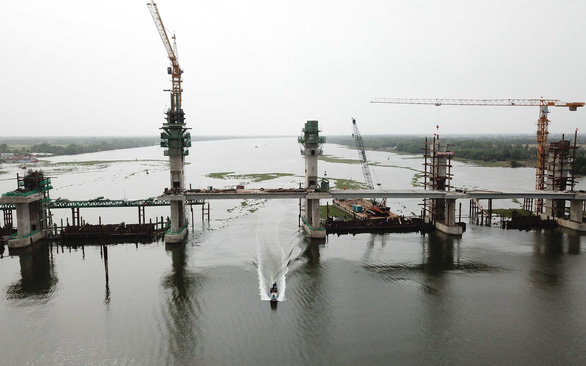Provincial authorities in Vietnam’s Mekong Delta are going to great lengths in order to mitigate the damage for local farmers during this year’s saltwater intrusion season.
Saline intrusion may encroach further on the inland waterways of the Mekong Delta and reach its peak between February 25 and March 4, the Southern Institute of Water Resources Research anticipated.
By mid-February, many canals in Phu Vinh Commune of An Giang Province – the gateway to the Mekong River in Vietnam – had been almost depleted, which troubled the irrigation plans of local farmers.
As witnessed by your correspondent, the Vinh An Canal in An Giang, a 12-kilometer-long flow that supplies water to local farming, has dried up to its bed in various sections.
The canal used to be filled to its brim, which made it easy for farmers to water their crop, according to Le Thanh Tung, deputy chairman of the Phu Vinh Commue People’s Committee.
However, irrigation was much more time-consuming and costlier after the water source was depleted.
Water levels in local canals will stay low as the Mekong River flow might fall 10-20 percent in the dry season of this year against previous years, according to Luu Van Ninh, director of the An Giang Hydrology and Oceanography Station.
Meanwhile, Kien Giang Province will record peak salinity levels at its river outlets during the high-tide occurrence in March and April.
During these months, local canals will serve as a conduit for brackish water to flow to areas between An Giang and Kien Giang, specifically those without a saltwater drainage system in place.
In Tri Ton and Thoai Son Districts of An Giang Province, salinity rates will peak in April and May at 0.2-0.3 grams per liter.
Urgent measures
Comparing to the upstream province of An Giang, other provinces down the flow of the Mekong River are facing even worse drought.
The potential damage from saltwater intrusion, however, was mitigated in Soc Trang thanks to proactive drainage management, freshwater containment, and saline prevention, said Pham Tan Dao, head of the provincial Water Resource Department.
“We've opened a canal to divert fresh water into rice fields and then closed the gates to conserve enough water for winter-spring rice cultivation," Dao said.
"We are entering the harvest season, which ends in about ten days.”
Local agriculture authorities advised against cultivating another crop of rice during this time due to risks of saltwater intrusion, he added.
Saline intrusion risks are also seen in Kien Giang, as a salinity rate of four grams per liter was reported to spread as far as 55 kilometers into the local Cai Lon River.
Taking cognizance of the situation, the provincial People’s Committee prioritized the optimal operation of the drainage system to prevent salinity and conserve fresh water for winter-spring rice crops and domestic water for residents.
"Thanks to the preemptive solutions, the province has not recorded any production loss from drought and salinity so far,” Dao noted.
In the neighboring province of Long An, authorities have started dredging canals and renovating irrigation pump stations to conserve water for the next dry season, said Nguyen Thanh Truyen, director of the provincial Department of Agriculture and Rural Development.
“Our Tan Tru and Thu Thua areas were not impacted, while the southern locales have also mitigated damage from saltwater intrusion by switching crop variants and conducting early germination,” Truyen said.
Root cause and solution
Water depletion in the Mekong River in late January and early February is caused by the renovation of the upstream JinHong Dam in China, which has throttled discharge flow to 1,000 cubic meters per second, according to Nguyen Kiet, head of forecasting at the Southern Region Hydro-Meteorological Center.
Major saltwater intrusion will take place in February, more specifically from February 10 to 15 and February 26 to March 2, while water volumes from the upstream Mekong River to Vietnam’s Mekong Delta may taper off 5-15 percent compared to a recorded average.
Saltwater levels will peak in the Vam Co River and Cai Lon River around March and April.
It is also anticipated that salt water of four grams per liter may spread a length of 55-75 kilometers from river outlets, 80-95 kilometers of the Vam Co River, and 45-52 kilometers in the Cai Lon River.
Kiet also denoted chances of off-season rain in the Mekong Delta during the dry months of 2021, which will help replenish fresh water and push back saltwater intrusion.
However, local authorities and residents should not rely on this possibility, as preemptive freshwater conservation remains the most realisitic solution.
“In the long run, a systemic design is required to bring fresh water from the Tien River to saline areas for desalination,” he remarked.
“Building embankments to prevent salinity does prove effective, but it's not a sustainable measure since it does not curb the saltwater intrusion in groundwater.”
Like us on Facebook or follow us on Twitter to get the latest news about Vietnam!


















































